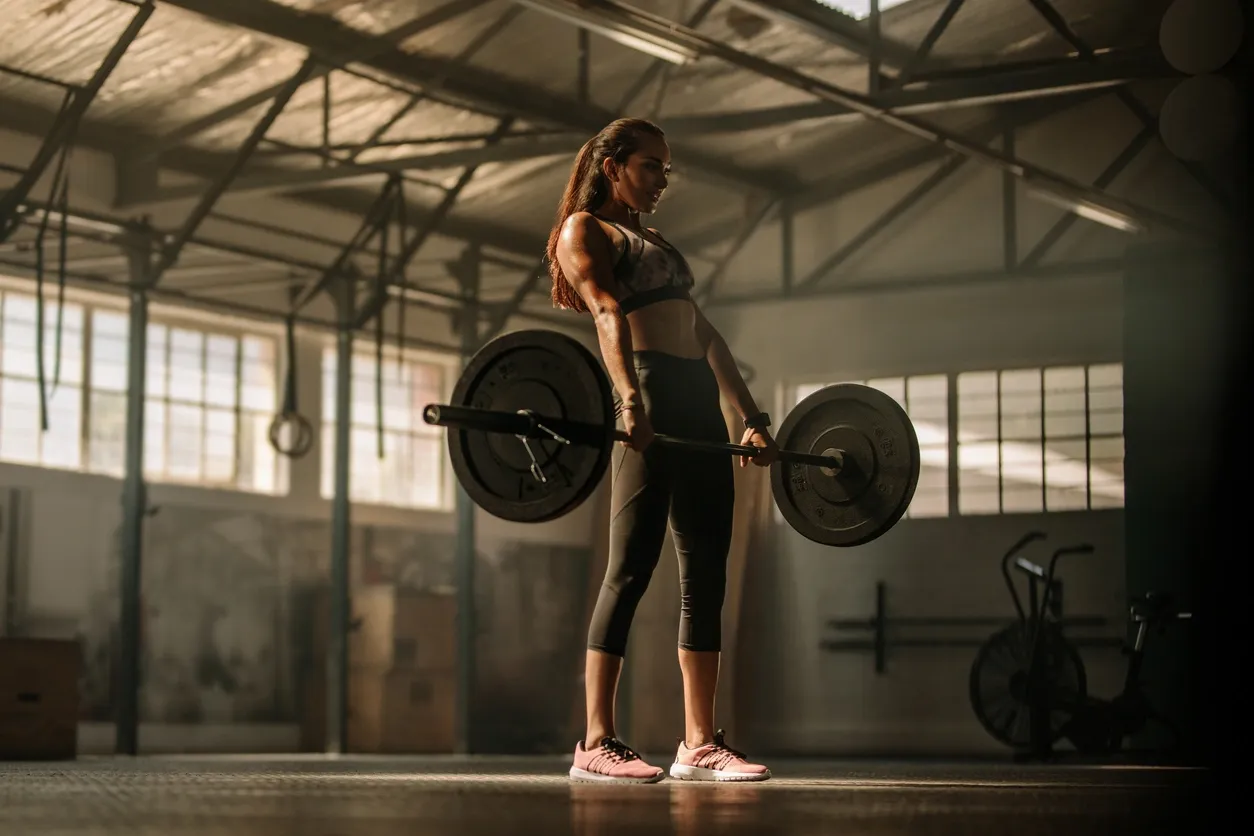Is there a greater feeling than the strain of trying to lift up something truly heavy? Yes, probably most feelings. But it’s still very satisfying and, dare I say, sensual. Today, we discuss the conventional deadlift which means your legs are inside your arms when you lift (in contrast to the sumo deadlift where the legs are wider than your arms). I’ll begin by listing some absolute rules. Violating these rules directly decreases the sensuality of your lift.
- Your low back must be set in a ‘neutral’ (meaning slightly arched) position and kept here for the duration of the lift. This is to avoid shear on the lumbar spine. Shear is a bad force on joints. Think of your joints as fluffy sheep who are very proud of their wool – they don’t want to be sheared at any cost. Injury is more related to the actual rounding motion of the low back under load. Meaning if you start with a very arched spine, it’s likely you will lose some of that arch during the lift which is dangerous. It’s actually safer to start with less arch and keep that amount than start with more arch and lose some. Remember, when you go to pull, keep your wool.
- The arms must be ‘long’ the entire lift. This means elbows straight – trying to lift the bar with elbows bent is a good way of tearing a bicep. This can happen when people “grip and rip” to try to jerk the bar off the ground. To be fair, most of these people were never told what to ‘rip’ specifically and so they may just be committing 100% to the lift. The other part of ‘long’ arms is a performance thing. The ‘longer’ your arms are, the less distance the bar will have to travel. There are 3 ways of functionally lengthening your arms. The first is keeping the elbows locked straight. The second is taking a shoulder width grip. Go ahead and stand up and let your arms dangle down. Notice how far down your body they are. Now spread them wide a few inches and notice that your hands rise up. Magic? Possibly. So, in general, you want them to hang straight down. Some people do need to take a wider grip because they are bigger and their stomach may get in the way of their legs so they take a wider stance and wider grip. Finally, shrug your shoulder blades down towards the ground and notice how your hands get lower. This actually comes in two delicious flavors. A) Strawberry blast: You can shrug your arms down with your shoulders rounding slightly forward (while keeping low back static) – this will allow you to start the lift with your hips slightly higher, but make locking the weight out potentially more difficult (depending on how strong your upper back is). B) Watermelon banana: You can shrug your arms down with your shoulders pulled slightly back – this will mean your hips aren’t as high at the start of the lift but lockout will be easier because you don’t have to pull your shoulders back at the end of the lift. In general, I would recommend people go with watermelon banana (shoulders slightly back). You don’t get to start with your hips as high, but in return you get an easier lockout and you can take a slightly wider stance because with your shoulders back, your arms are a little wider while still vertical. A wider stance also decreases the distance the bar has to move (hence why most lifters can deadlift more in sumo position than conventional). However, the easiest way to find out is to try both positions and see what actually works for you.
- You shins should not be tilted outward or inward – meaning your feet and thighs should point the same direction. This minimizes shear on the knee sheep.
- The bar must touch your shins (until past the knees, obviously). This means starting with the bar on your shins and sliding the bar up your shins as you lift. The fronts of your shins are basically pole dancers trying to pay their way through med school. If they want to reach their goal, they gotta work the pole. So keep the bar close – for their sake. Letting the bar get away from you will also dramatically increase the leverage acting on your low back and hips, making the lift much harder and much less safe. This is the most common mistake people make. But the correcting cue most often given, “pull the bar into your legs”, is also not really correct. This goes into the next absolute.
- Your arms must hang vertical at all times. This absolute, which I’ve saved for last, is the king. It’s almost always mentioned in deadlift articles, but it’s importance is not emphasized enough. If you made a model of a human deadlifting (and why wouldn’t you?), they would form a closed loop from the hands on the bar, up to the shoulders, through the trunk to the hips, down the thighs to the knees, and down the shins where the loop would be closed where the shins meet the bar. Of all of those segments, the orientation of only one stays constant – the arms hanging vertical. This is because the arms are holding onto a very heavy weight which is constantly pulling the arms vertical. It would take a ridiculous amount of shoulder strength to pull the arms out of this vertical position – with a heavy deadlift, that’s not happening. So the arms will hang vertical. Try this: get into the deadlift position and let your arms dangle straight down. Now straighten your knees a few inches while keeping hips at same angle and notice where your arms now hang: your hands will be several inches away from your body. Now how are you legs supposed to pay for grad school? Straightening the knees too quickly without straightening the hips at a compatible pace is why people lose the bar forward. It’s also why telling them to pull the bar to their body (a shoulder extension cue) is addressing a ‘symptom’ rather than the root cause.
I’ll discuss the cue that should be used to keep the bar close next post. For now, I’ll go over setting up the deadlift based on the absolutes. Because the body forms a closed loop with the hands on the bar and the bar on the shins, if the arms are kept vertical and the bar touches the shins, then there is only 1 given body position at each bar height. The bottom position is then determined by 1 variable: bar placement over the foot. The further forward the bar, the more dorsiflexion at the ankle required to touch the shins to the bar. From here, there is only 1 angle that the knees and hips can be at to allow the arms to be vertical. The further back the bar is, the closer to the shins, and the more vertical the shins can be. Again, with the arms vertical and the shins touching the bar, there is only 1 position body position. The further back the bar, the higher the hips (more knee extension) and the more vertical the shins. Generally, the bar should be placed over the middle of the length of the foot, for balance. Too far forward and the hips will need to be very low for the arms to be vertical (which is fine if you’re doing an Olympic-style deadlift). Too far back and the hips will be too high, resulting in losing the bar forward.
With all lifting form, I always recommend you start with general guidelines but use this position only as a starting point. From there, it’s best to do multiple sets at the same weight and experiment with variations to find your strongest position. People vary in their limb and torso length ratios and other factors. If you’re truly interested in maximizing your lifts, take the time and effort to learn what works for your body. That said, here’s the process. I’d recommend using a weight that is moderately heavy like 80% your max and do 2-3 reps at a time with this same weight.
- Pretend like you’re going to jump as far forward as you can. This is your starting stance width. Make sure your knees and feet point the same direction.
- Start with bar over the middle of the anterior-posterior length of your foot. If your foot points straight forward, this is just the middle of the foot. The more your foot points outward, the ‘shorter’ the anterior-posterior dimension of the foot, bringing the middle of the length of your foot closer towards your shins.
- Get in the bottom position where your shins touch the bar, your low back is set, and your arms are vertical.
- Deadlift the weight.
- If your knees were not touching your arms in that position, then widen your stance 1/2 – 1 inch on each side and then get into position, with all the requirements (bar on shins, back set, arms vertical). With the bar in the same position over the foot but the stance wider, you will need to ‘squat’ a little lower to get into the correct position.
- Deadlift the weight. Compare to how the first position felt.
- Continue slowly widening your stance, deadlifting, then comparing until you can’t go wider because knees are touching your arms.
- Now for the opposite. From the widest stance, bring both feet in 1 inch and then turn your feet out a little bit extra. Go down into the bottom position with all requirements met. With your feet pointing more outward, in order to keep thighs and feet aligned, you will have to open your hips up and push your knees out. You should turn the foot out and push your knees out enough that your legs are touching or near touching your arms. This will result in your hips being closer to the bar, but more knee flexion required to get the arms vertical – thus decreasing the load on the hip, but increasing the load on the knee. This style of deadlift is a little more technical as well because your foot will point more outward, thus ‘shortening’ the anterior-posterior length of it which makes balance more difficult (similar to sumo deadlift).
- Deadlift the weight.
- Continue narrowing your stance incrementally, turning your feet out and pushing your knees out more, deadlifting, then comparing until you’re not flexible enough to open your hips anymore, your heels are touching, or there’s a clear drop off in strength.
- As you go through this process, make sure you note which positions to come back to, to compare them.
- Some people may be strongest with as wide as stance as their arms permit, some people may be strongest with a narrow, frog-like stance, but most people will be strongest close to the horizontal jump stance.
- You’ll only know what’s best for you if you experiment!

